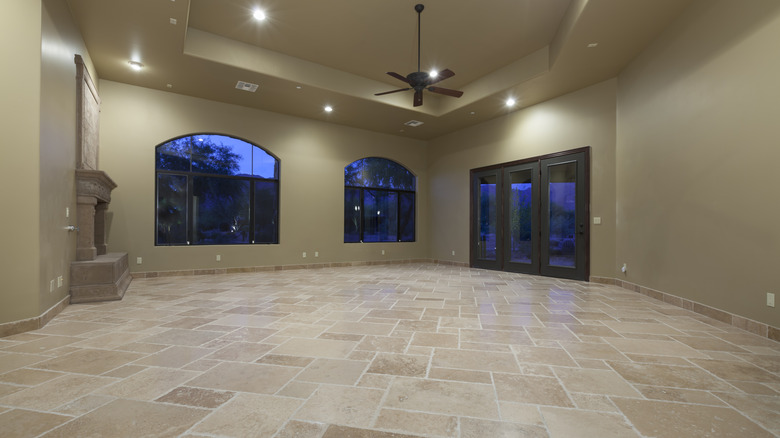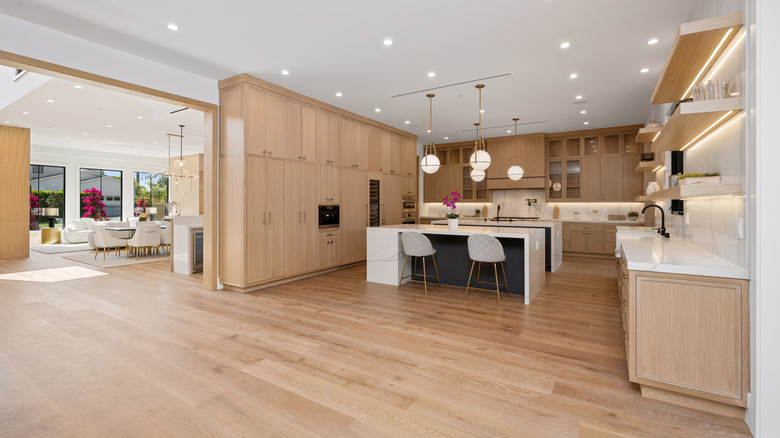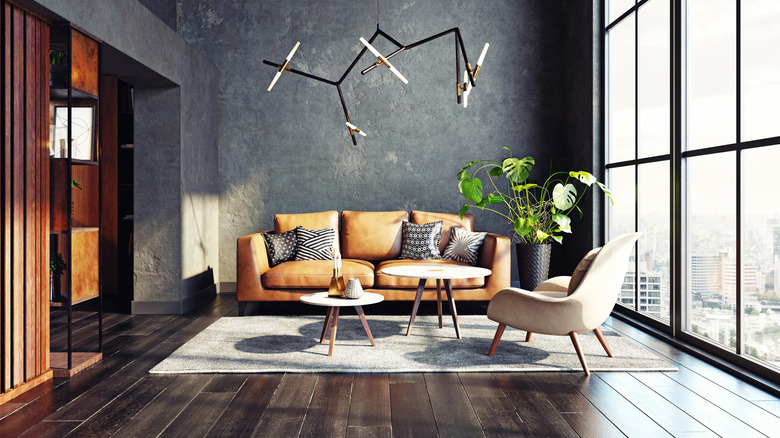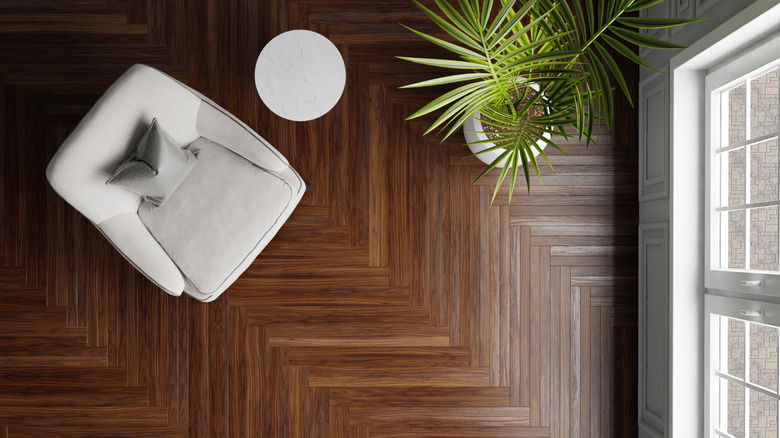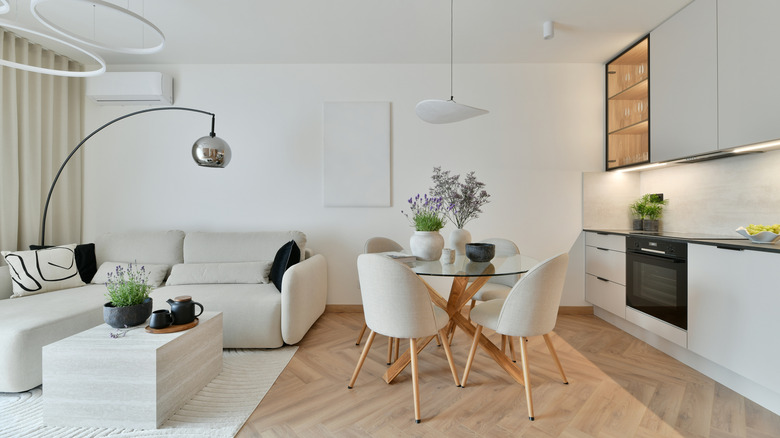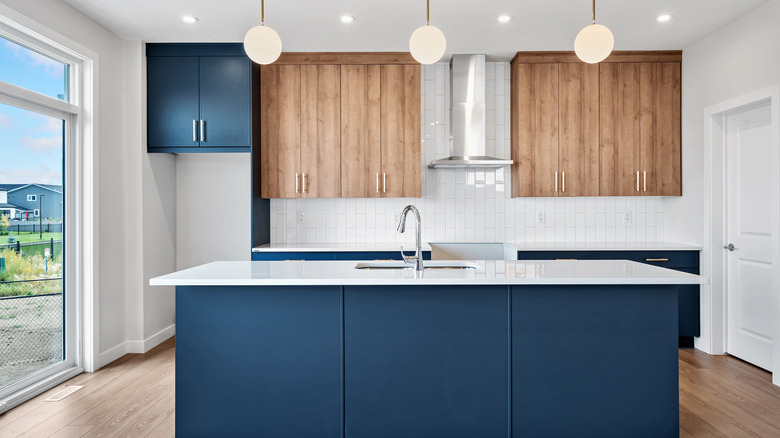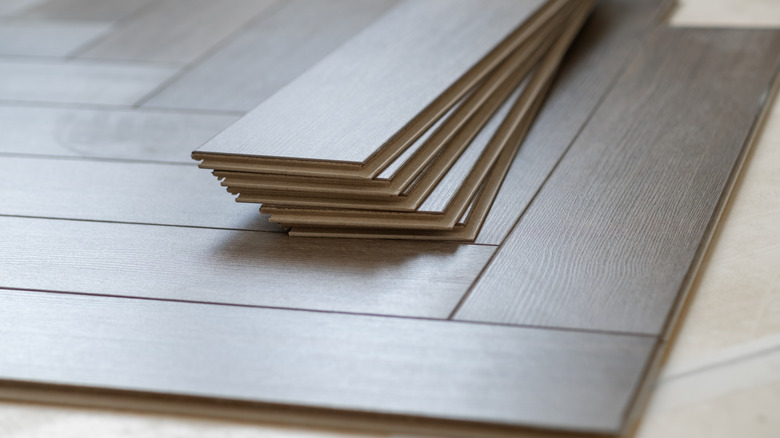Christina Haack's Expert Design Tips For All Things Flooring
With two decades of real estate experience, Christina Haack is well-versed in what it takes to sweep potential home buyers off of their feet. And while house hunters are easily wooed by spacious kitchens, spa-like bathrooms, and roomy walk-in closets, the design expert wouldn't brush one crucial aspect under the rug. "Flooring is my thing," Haack noted to People, explaining why she, uh, flipped over the chance to launch Christina Collection, her own line of luxury vinyl plank flooring. "It's the first thing I notice when I walk into a house and in my opinion, it makes or breaks the home."
But she swears it's not that hard to get on solid ground. While real wood has been held up as the gold standard, Haack says there's a slew of budget-friendly options that are as easy on the wallet as they are on the eyes. Among her favorites is the snap-into-place stone plastic composite planks that make up her 21-shade line. Because, while the faux wood planks are an affordable pick, they're also a smart choice for those with cash to spare. "You could have a $30 million luxury rental on the Malibu coast, where you won't have to worry about the durability of your floor," she explained to Floor Covering News. "It's the value in the product being scratch-proof and water resistant." And that's just one bit of design advice she's got that will leave your guests floored.
Real hardwood isn't a must
Shelling out for pricey hardwood isn't a necessity to give your home a wide-ranging appeal. While laminate flooring can have a shaky reputation, Haack insists that luxury vinyl planks not only resemble the real deal, but they're actually far more durable. She equates the budget-friendly option to quartz countertops, the heartier stone that's become a top choice for kitchens. "Once upon a time, people wanted marble because it's beautiful," Haack explained to Floor Covering News. "Well, it's also porous. You leave a cup on it, you're screwed. You spill red wine on it, you're screwed." The faux wood planks are a similarly smart choice. Noted Haack, "These SPC floors are to hardwood what quartz counters are to marble."
Haack is obviously partial to her brand and its pleasing palette of neutrals. But there are a slew of vinyl plank floor brands that look like real wood. Lifeproof — available at Home Depot — has a high level of durability with a built-in foam that creates moisture resistance, thermal insulation, and sound insulation. CALI offers attractive extra wide planks with superior thickness, while Deco Products gives homeowners a more distressed, rustic look.
If you have pets or children, you'll need more durable flooring
No bones about it: Dogs and kids can be pretty tough on floors. "Every time I do a house, here's what I say: I have young kids and I have dogs. I do not want a floor that scratches, and I do not want a floor that will be ruined if I spill something on it," Haack explained to Floor Covering News. "That's what everyone wants." In fact, she'd wager that "not taking into consideration pets and kids" is the biggest mistake home buyers make with flooring. As she put it to Parade, "Pets have little nails and children, obviously, spills and everything. So I just say really knowing what your heavy traffic zones are like, and understanding that certain materials can be more porous than you may expect."
Her go-to luxury vinyl flooring also ranks high when it comes to flooring options that are easy to install. So it's a good option for DIY types no matter if you use the click-and-lock, glue-down, or GripStrip method. Other relatively straightforward picks for those looking to lay it all out on their own include carpet tile floors, linoleum planks, and laminate.
You might regret picking something trendy
When it comes to something that literally covers every square inch of your space, you want something you truly love. So, unless you're confident you'll still be passionate about that patterned porcelain tile years down the line, it's smart to go classic. As Haack told Parade, "I would say stick with a bit more, if you can, on the timeless side." While she's in favor of laying down different flooring in a bathroom or laundry room, "When it comes to the whole house, I would say sticking with a classic flooring, a classic color."
Haack's pick would be the Camelback from her Christina Collection, noting it's a safe option that's "not too light. It's not too dark." But she's not the only design expert to have opinions about the best floor colors. Consider grounding your flooring in other popular shades like a light natural oak, warm honey, or whitewashed wood. Before choosing the right hue for your home, though, take into account your cleaning habits. Lighter shades could do a better job of hiding dirt, debris, and any kid- or pet-related scratches.
Travertine can be tough to remove
Speaking of materials that fall out of favor, "Like 15 years ago, everything was really heavy like travertine," Haack noted to Parade. "It was kind of like travertine on brown and everything felt very dark." And now that it's not as popular of a pick, "I think when buyers look at that style, it's harder to fix," said Haack, "because travertine's a hard material to get rid of."
Plus the stone is one of the more high-maintenance materials you can have in your home, easily damaged by acids, even those found in fruit juices. Other decor materials you might choose to avoid (unless you truly love scrubbing and sweeping) include bronze hardware, which can turn dark brown or green as the surface oxidizes, the endless grout found in penny tiles, and the sort of dark hardwood floors that highlight every dog hair and smudge of dirt.
Having the same flooring throughout can make a home appear bigger
When it comes to floor covering, Haack likes more of the same. Though she understands the desire to change things up in certain spots like bathrooms and can get behind picking a cool tile for your entryway, "I like sticking with the same flooring throughout bedrooms, throughout the whole house," she told Parade. "I like consistency. I feel like it makes houses look bigger."
That choice can also grow your home's resale value. Having consistent flooring throughout a house can help it sell faster. Even if it's not all fully identical, try using the same tile in both the kitchen and bathrooms, and similar carpets in the bedrooms. As for laminates and woods used, ideally they'd be the same shade, even if they're not the exact same material.
Rugs are an easy way to add visual interest
Allow Haack to lay out her case for filling your home with area rugs. While there's value in keeping your base flooring consistent throughout your home, topping spaces off with rugs of various colors, patterns, and textures can stop things from feeling humdrum. "I like just putting down a rug because those are affordable and easy to switch out," she noted to Parade. "All [of] our rooms have rugs because that adds a pop too. It doesn't feel so boring and it's just like the same flooring throughout."
It's an easy way to, uh, cover your bases, but there are a few steps you shouldn't skip when choosing an area rug. To select the proper size, you'll want to carefully measure the seating area, opting for a rug that allows for at least 15 inches of space between the edge and the wall. You'll also want to consider if you want a darker or lighter shade, the latter being a good choice if you're hoping to make the space feel larger. And when it comes to material, it's important to take note of how much tread it will have to endure. In more high-traffic areas, it's wise to go with durable natural fibers like wool, cotton, and jute.
Dark flooring can actually brighten up a space
Dark shades do not have to mean a drab feeling. While it may seem counterintuitive, during a Season 4 episode of "Christina on the Coast," Haack suggested a darker shade of luxury vinyl flooring, noting the richer shade would pop against the black lower cabinets and oak upper cabinets the couple had selected. "Darker floors paired with contrasting cabinets can make a space feel bigger and brighter," Haack explained on the series (via Realtor). And with a ton of natural light in the pair's kitchen, she added, "It's never going to feel too dark in there."
To select the right color hardwood for your home, you'll also want to think about how much foot traffic it will receive and if the space has a lot of natural light. While a more saturated hue will work just fine in a space with a lot of windows, if the room is darker, a lighter shade can help brighten things up. And don't forget to take into account your existing wall color and other furnishings. As a general rule, the color of the floors should be darker than that of the walls.
A unique pattern doesn't have to break the bank
Creating a fun flooring design with hardwood can be quite pricey when you take into account the cost of labor for laying down the pieces in an eye-catching pattern. But creating that look doesn't have to be costly. Case in point: the secret Haack let her clients in on during Season 1, Episode 3 of her "Christina in the Country" series. With luxury vinyl flooring, there's an option to choose planks already printed with a chevron design. "If these weren't designed like this, as boards, then very complicated; time-consuming, expensive, so many cuts," she noted of the style. "But the fact that it comes like this, it's pretty easy."
Another not-so-basic flooring trend to consider is a herringbone pattern. They feature a V-shape style quite similar to the chevron, just with a slightly messier, more organic vibe. Made with rectangular planks laid out at 90 degrees from one another, it's more of an asymmetrical broken zigzag look, while the chevron planks are cut at an angle so they fit together to form a point.
You'll want to test how the flooring works with your existing decor
Much like the concept of measure twice, cut once, you want to do a test run before committing to a house full of wood planks, vinyl, or tile. "When picking flooring, as in picking anything, it's really, really a good idea to get the samples and take them home with you," Haack instructed in a 2022 TikTok. "Different lighting looks different in all different types of houses, and also the way the flooring plays off your current paint color is very important." Which is why she advises getting a sample piece to check out how it looks IRL. As Haack noted, "What you think would look great online, could look totally different in person."
And that's just one aspect you need to consider before installing hardwood flooring in your home. In addition to your ideal budget and shade, you also need to think about the finish. For instance, you could opt for a distressed look that is not only trendy and heavy on the charm, but a sly way to hide any flaws or imperfections. Another popular option is a low-sheen water-based polyurethane, which can help protect the wood from nicks and scratches.
And don't forget to check out how flooring looks under various lights
Viewing your flooring under all types of light can be quite illuminating. Depending on the time of day, wood floors can appear lighter or darker as natural light streams in, meaning they can either complement the rest of your home's decor — or clash with it completely. It's a flooring rule Haack always follows, as discussed in Season 1, Episode 6 of "Christina in the Country," when her clients expressed interest in a red oak. "There is a potential that it could pull a different color," she noted. While in the shade, "it doesn't look like it would pull anything," she added, "but if we put it in the sun, it gets redder."
And if your home is awash in windows, you may want to rethink the material altogether, as hardwood flooring may not be the best option if your home is filled with natural light. Much like us, natural wood reacts to the sun's UV rays, meaning it can fade over time when it's exposed to prolonged daily sunlight. To counteract that, you can re-coat your floors every three to four years, or even refinish them by sanding the finish off and re-staining it. Another option is to add window film to your existing panes, which will let you soak up some sun, while still decreasing its intensity.
When it comes to mixing cabinet colors and flooring, opposites can attract
Too much of a cool thing isn't, well, cool. Cabinetry in an icy shade of blue might seem like it plays well with cooler-toned flooring, but the combo can read one-dimensional. This is why Haack loves pairing a cool-hued cabinet (think: light blue, lavender, green) with a darker walnut floor. As she explained on her series "Christina on the Coast" (via Realtor), "the warm and cool mix very nice together."
To get the right recipe, you'll want to pick one focal point — like the cabinetry or a bold backsplash — to build around, balancing the statement-making piece with grounding neutrals. And if you're looking for a good place to start, try light blue — considered a new neutral for timeless kitchens. Pairing nicely with metallics, natural stone, and hardwood, it works the same as a white, gray, or sage, but adds a little something extra. And if you're not ready to fully dive into the trend by using it as a wall color, cabinet shade, or even backsplash, consider dipping just a toe in with accessories like towels, small appliances, or even dishware.
Don't forget to let flooring acclimate to the environment
The idea that all good things come to those who wait also applies to home renovations. Because materials can react to temperature changes or humidity in the air, giving your flooring time to acclimate to your home's environment ensures it won't later shrink or expand. The process allows the planks to fully reach an equilibrium before they're locked into place. As Haack advised on her brand's Instagram, "Be sure to acclimate the hardwood floors for at least 48 hours in the room where it will be installed in."
During this two-day waiting period, you'll want to track the room's temperature and humidity levels to ensure there aren't any dramatic swings. A hygrometer will help you keep the humidity levels in the ideal 45% to 65% range that mimics the typical indoor conditions of a home. Two or three days is the aim, but keep in mind that engineered or solid woods may need a longer acclimation process.




